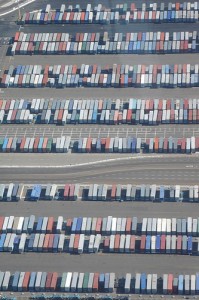Robotic ferret to detect hidden drugs and weapons

The monumental task of inspecting containers that come in to and out of seaports and airports may get a bit easier with a new type of robot being developed to detect drugs, weapons, explosives and illegal immigrants concealed in cargo containers.
Dubbed the 'cargo-screening ferret,' the device has been in development since early 2008 at the University of Sheffield, and is being funded by the Engineering and Physical Sciences Research Council (EPSRC).
According to a press release, the ferret (sorry no image available as of time of writing) will be the world's first cargo-screening device able to pinpoint various illicit substances and the first designed to operate inside standard freight containers.
When placed inside a steel freight container, the ferret will attach itself magnetically to the top, and then automatically move around and seek out contraband using a suite of sensors that are more comprehensive and more sensitive than any currently employed in conventional cargo scanners. It will send a steady stream of data back to its controller.
The real breakthrough that makes this robotic solution possible are the latest advances in both laser and fiber optic technology that makes it possible to detect tiny particles of different substances.
"The EPSRC-funded project team is developing sensors which incorporate these technologies and that are small enough to be carried on the 30cm-long robot, in order to detect the specific 'fingerprint' of illegal substances at much lower concentrations than is now possible," writes the article.
Dr Tony Dodd, who is leading the project said; "It's essential we develop something which is simple to operate and which Border Agents can have total confidence in. The ferret will be able to drop small probes down through the cargo and so pinpoint exactly where contraband is concealed."
Current cargo-screening methods rely on a variety of separate methods to detect contraband, such as sniffer dogs and external scanners for detecting explosives and drugs and carbon dioxide probes and heartbeat monitors to detect a human presence. Scanners at seaports and airports typically only generate information on the shape and density of objects or substances. The ferret will be able to do the same, and take the next step to tell what it actually consists of as well.
It will take a few more years before working prototypes of the cargo-screening ferret could be ready for testing, with potential deployment within around five years.
